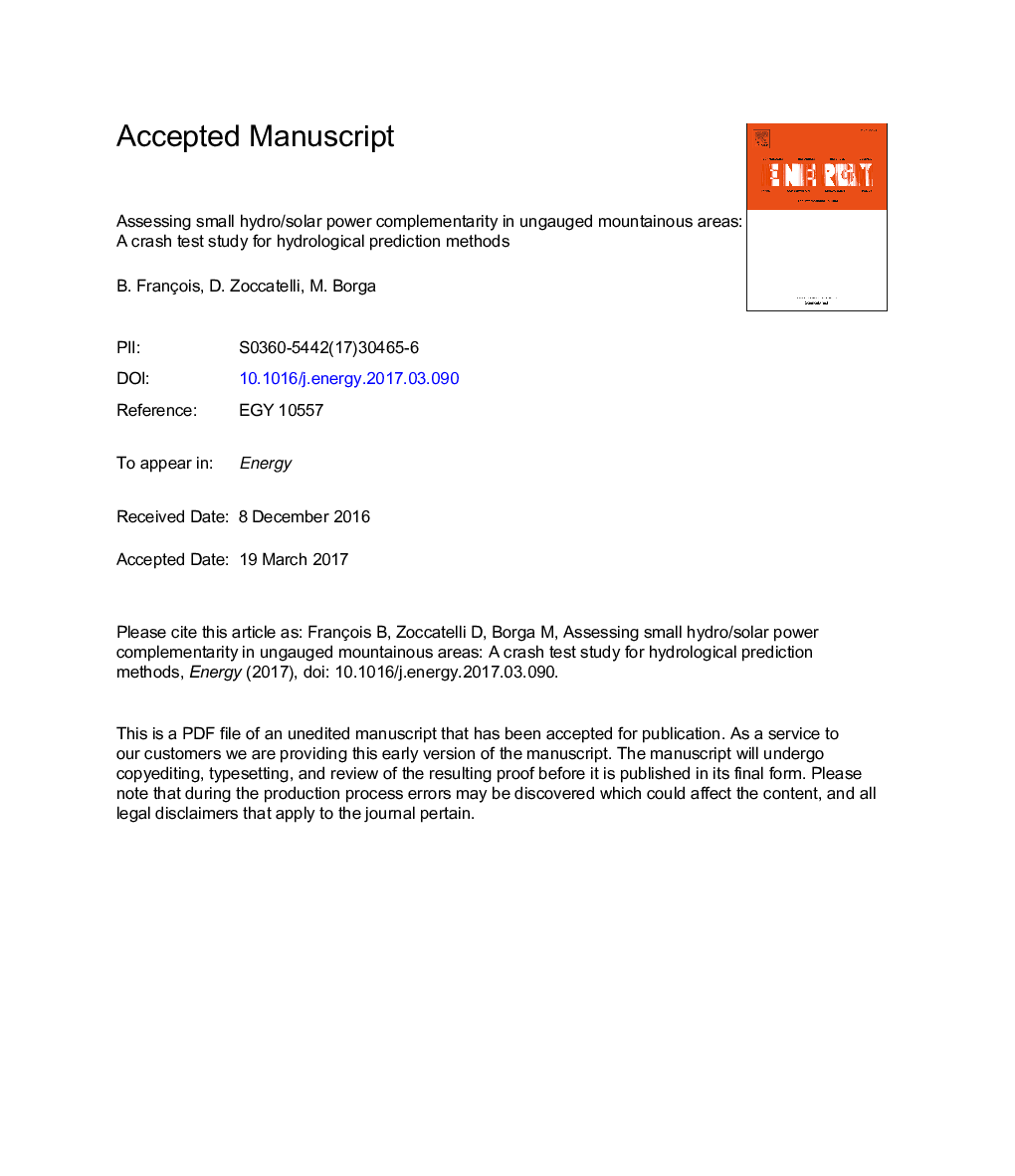| کد مقاله | کد نشریه | سال انتشار | مقاله انگلیسی | نسخه تمام متن |
|---|---|---|---|---|
| 5476845 | 1521424 | 2017 | 41 صفحه PDF | دانلود رایگان |
عنوان انگلیسی مقاله ISI
Assessing small hydro/solar power complementarity in ungauged mountainous areas: A crash test study for hydrological prediction methods
ترجمه فارسی عنوان
ارزیابی کمبود نیروی برق آبی / خورشیدی در مناطق کوهستانی ناحیه ای: یک مطالعه تست تصادفی برای روش های پیش بینی هیدرولوژیکی
دانلود مقاله + سفارش ترجمه
دانلود مقاله ISI انگلیسی
رایگان برای ایرانیان
کلمات کلیدی
ترجمه چکیده
در بسیاری از مناطق ادغام برق آبی کوچک با انرژی خورشیدی / باد به عنوان راهی برای دیدار با اهداف انرژی تجدیدپذیر مورد بررسی قرار گرفته است. درک درستی از پتانسیل این ادغام در حوزه های اندازه گیری شده به طور ضعیف مهم است. ما مهارت های مختلف روش های پیش بینی هیدرولوژیکی را برای پیش بینی مکمل بودن بین نیروی دریایی رودخانه و انرژی خورشیدی در حوضه های کوهستانی کوه های آلپ ایتالیا مورد بررسی قرار می دهیم. دو نوع روش پیش بینی استفاده می شود: یک مدل هیدرولوژیکی نیمه توزیع شده، مفهومی و یک روش شاخص براساس نسبت مساحت زهکشی. در مورد مدل هیدرولوژیکی، کارایی روش را تحلیل می کنیم، زمانی که پارامترهای مدل نمی توانند کالیبراسیون شوند، اما باید از حوضه اهدا کننده که اطلاعات کالیبراسیون در آن موجود است انتقال یابد. مکمل بین دو منبع انرژی با استفاده از انحراف معیار تعادل انرژی به عنوان یک پروکسی از هزینه های سیستم متعادل مورد بررسی قرار می گیرد و بر روی مقیاس های تجمعی زمانی محاسبه می شود. نتایج نشان می دهد که عملکرد به مقیاس زمانی بستگی دارد و تاثیر خطاهای فاز کوچک در پیش بینی هیدرولوژیکی را مشخص می کند. به طور کلی، روش فهرست بهتر برای حوضه های غالب برف رانندگی بهتر عمل می کند در حالی که مدل هیدرولوژیکی برای حوضه های بارانی بهتر عمل می کند.
موضوعات مرتبط
مهندسی و علوم پایه
مهندسی انرژی
انرژی (عمومی)
چکیده انگلیسی
In many regions, the integration of small hydropower with solar/wind energy is examined as a way to meet renewable energy targets. A good understanding of the potential for this integration in the typically poorly gauged catchments is important. We examine the skill of different hydrological prediction methods to predict complementarity between run-of-the river hydropower and solar power in data sparse mountain basins of the Eastern Italian Alps. Two kinds of prediction methods are used: a semi-distributed, conceptual hydrological model, and an index method based on the drainage area ratio. In the case of the hydrological model, we analyse the efficiency of the method when the model parameters cannot be calibrated but must be transposed from a donor catchment where calibration data are available. The complementarity between the two energy sources is examined using the standard deviation of the energy balance as a proxy of the balancing system costs and it is evaluated over different temporal aggregation scales. Results show that the performance depends on the temporal scale and outlines the impact of small phase errors in hydrological prediction. In general terms, the index method performs better for snowmelt dominated catchments while the hydrological model performs better for rain-fed catchments.
ناشر
Database: Elsevier - ScienceDirect (ساینس دایرکت)
Journal: Energy - Volume 127, 15 May 2017, Pages 716-729
Journal: Energy - Volume 127, 15 May 2017, Pages 716-729
نویسندگان
B. François, D. Zoccatelli, M. Borga,
